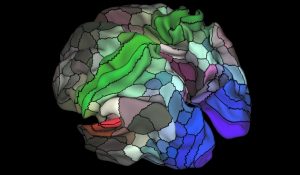We don’t use 100-year-old maps to get around town. Yet neuroscientists are still using some maps of the brain made a century ago to help navigate the complex pathways and regions of our most important organ. That need for fresh information is precisely what inspired one team of researchers to create the most detailed map of the human brain ever seen.
The new map published in the journal Nature details almost 100 previously uncharted regions in the cerebral cortex and gives scientists the power to make groundbreaking new discoveries about how we think, develop, and speak as well as how we’re affected by diseases like autism, schizophrenia, and dementia.
Led by neuroscientist Matthew Glasser at Washington University Medical School, researchers used advanced scanners and a machine learning algorithm designed by scientists from Oxford University to pinpoint hidden regions of the brain on hundreds of test subjects. The results divide the two hemispheres of the brain into 180 areas based on features such as physical differences and neural connections.
From the surface, the brain looks pretty similar all over – wrinkly and gray. But the utility of this new map lies in its distinguishing unseen divisions within the brain. It’s sort of like looking at a map of state borders as opposed to visible topography.
“The brain is not like a computer that can support any operating system and run any software,” said neuroscientist David Van Essen from the Washington University School of Medicine in St. Louis, who led an international team of researchers for the study.
“Instead, the software – how the brain works – is intimately correlated with the brain’s structure – its hardware, so to speak. If you want to find out what the brain can do, you have to understand how it is organised and wired.”
Still, some regions are more clearly understood than others. One region named 55b is linked to language and becomes active when we hear a story. Others are linked to a person’s field of vision or in controlling movement. But some are linked to more than one function and don’t fit neatly into a single division. There’s still more to be done and it’s likely some of the 180 identified regions of the brain will be subdivided in future research.
“This map you should think of as version 1.0,” Glasser said. “There may be a version 2.0 as the data gets better and more eyes look at the data. We hope the map can evolve as the science progresses.”
Still, it’s a solid starting place for further research and improvements in the field of neuroscience.
“These new insights and tools should help to explain how our cortex evolved and the roles of its specialised areas in health and disease,” said Bruce Cuthbert of the US-based National Institutes of Health, which co-funded the research.
One day, it may enable “unprecedented precision in brain surgery,” he added.











